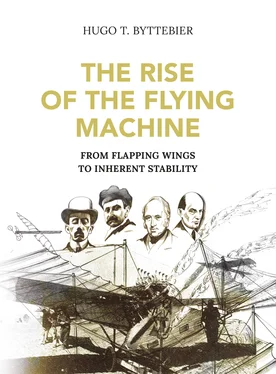A few years later Jacob Degen, another German fascinated by mechanics and a clockmaker by profession, built an ingenious machine shaped like a double umbrella which was moved by the force of his legs and arms. Degen was never able to achieve free flight, although a newspaper’s claim that he had done so inspired Sir George Cayley to write his famous 1809-1810 triple paper.
The title of Lilienthal’s book, Bird Flight as the Foundation of the Art of Flying ( Der Vogelflug als Grundlage der Fliegekunst ) was reminiscent of Meerwein’s 1784 essay The art of flying like birds ( Die Kunst zu fliegen nach Art der Vögel ).
In his book Lilienthal expounded his theory about flight and the means of achieving it, resulting from years of research and observation of live birds, of experiments with small models and of theoretical considerations. He also wrote about his visions of a Utopian future and included some poems exalting the ideal of flight and expressing the hope that man would soon emulate birds. His ideal was soaring flight as he had seen storks achieve in his native Pomerania.
The principal lesson Lilienthal had learned from the great soaring birds was the use of curved wings and he was convinced that this discovery, which he made in 1873, would open the way to the skies. He was not acquainted with the writings of Phillips and Goupil and he may be excused for thinking that his discovery was original because, as late as 1892, Hureau de Villeneuve, in an appraisal of Lilienthal’s book, was still convinced of the superiority of flat wings.
The book caused quite a stir and was eventually translated into English, but Lilienthal achieved fame because he did not limit himself to theoretical speculations, being one of the first to start practical experiments. The year after the publication of his book he built a full-sized glider that would carry him aloft and allow him to fly, in the manner that had been proposed by de La Landelle in his article about the “dirigible parachute” in 1884.
Lilienthal’s original idea was to fly by means of flapping wings, but as a preliminary he decided to try a fixed-wing soaring machine that was easier to build and simpler to handle. He thereby became the originator of the modern sport of hang-gliding.
During most of his experiments Otto Lilienthal was assisted by his younger brother Gustav and the pair prefigured the activities of the equally famous Wright brothers in the US. In both cases the older brother was the driving force who gave his life for his ideal and the younger brother devoted the remaining years of his life to the vindication of their vision.

The First Powered Experiments
As mentioned above, in 1888 Léon Serpollet invented, or rather dramatically improved, the flash steam generator which permitted the construction of a very light and powerful engine, the light powerplant that had hitherto eluded the aviation pioneers’ efforts.
A precursor in the use of power in a full-sized aeroplane was the Frenchman Clément Ader, who was continually on the brink of success but never quite achieved it.
Born in 1841, Ader was from early youth attracted to the mechanical sciences. He worked for a time on the railways and was continually thinking of new inventions. There is a certain inevitability about his becoming interested in human flight.
He built a flapping-wing machine in 1873, but then turned his attention to a new wonder of applied science, an electric machine that could transmit sounds over great distances. By 1880, the telephone had made him rich and famous, having in 1878 improved on the telephone invented by Alexander Graham Bell, and then in 1880 he established the telephone network in Paris. So, in 1881 he returned to aviation. Mouillard had just published his book and it made a deep impression on Ader, who decided to dedicate his efforts to the achievement of flight by means of a soaring machine moved by mechanical power.
In 1881 he travelled to Strasbourg so as to observe the storks there, and the following year he visited North Africa with the purpose of watching the great vultures.
His investigations showed him that the soaring birds always took off against the wind, as Lilienthal had also observed, and that the birds never left their nests when there was no wind.
Continuing his investigations, Ader became spellbound by the perfection of the bat’s wings and decided to use this animal as a prototype for his flying machines, in spite of its questionable aesthetic appeal.
Around 1889, he was working on the creation of his first mechanical bat which would be able to carry a man and would be powered by a steam engine fed by a Serpollet-type generator. His machine was to fly with fixed wings and was to be driven by a propeller moved by an extremely light and ingenious two-cylinder compound steam engine of about 20 hp.
Details of the progress of his construction are scant because Ader worked in secrecy, having in mind the importance of his plans for national defence. Such secrecy does not help the historian who is trying to assess what was real and what was imaginary in the flight or flights Ader claimed to have made. During the next decade he spent a fortune on the construction and perfection of several flying machines. This will be related in a later chapter.
Another pioneer of mechanical flight was Hiram Maxim, who decided in 1889 to create a real-life or rather a larger-than-life flying machine, regardless of cost and effort. Born in 1840 in the US, Hiram Stevens Maxim made a fortune from several inventions, the most noteworthy being the lethal machine-gun which was to cause so many casualties during the First World War.
It was inevitable that Maxim was also to become attracted to human flight and in Great Britain, where he lived from 1881, Maxim began to study aviation in earnest in 1887. Maxim, who was sure of his own capabilities, said that he could solve the problem in five years if he was allowed to spend £100,000 ($500,000). The money, or a great part of it, was indeed spent but, although Maxim did become a true expert on aviation, he did not reach the definitive solution.
His plan was to dedicate three years to perfecting a suitable internal combustion engine along the lines of the system invented by Brayton or by Otto, but as neither type was at that moment adaptable as an aviation powerplant he did not go ahead with his plan. Meanwhile the technique of drawing steel tubes had become so perfected that it had become possible to build them with such a small inner diameter that, when heated, the water inside evaporated instantly.
This system was perfected by Serpollet in the flash steam generator, so Maxim, like Ader, was forced to turn to steam power for the great aeroplane flying machine he had in mind.
Maxim had already carried out experiments with a whirling arm and a wind tunnel, and in 1889 he decided to leave speculation and small-scale experiments and get down to the realization of man’s age-old dream. He applied for two master patents; then he engaged two first-rate craftsmen from the US and began the construction of a huge flying machine on his property of Baldwyn Park in Kent, in order, as he stated, to experiment with a real aeroplane instead of continuing to elaborate theories, as most of his predecessors had done. It was soon possible to evaluate the results he obtained.
The year 1889 was also remarkable for the great number of experiments with piston internal combustion engines as well as those driven by steam.
Daimler and Maybach, who had conceived the light internal combustion engine seven years before, built a V-twin cylinder engine during 1889. In this engine two pistons worked on a single crankshaft by means of forked connecting rods and this may be considered as the ancestor of the great number of V-8 and V-12 engines that were to be built thereafter.
Читать дальше













